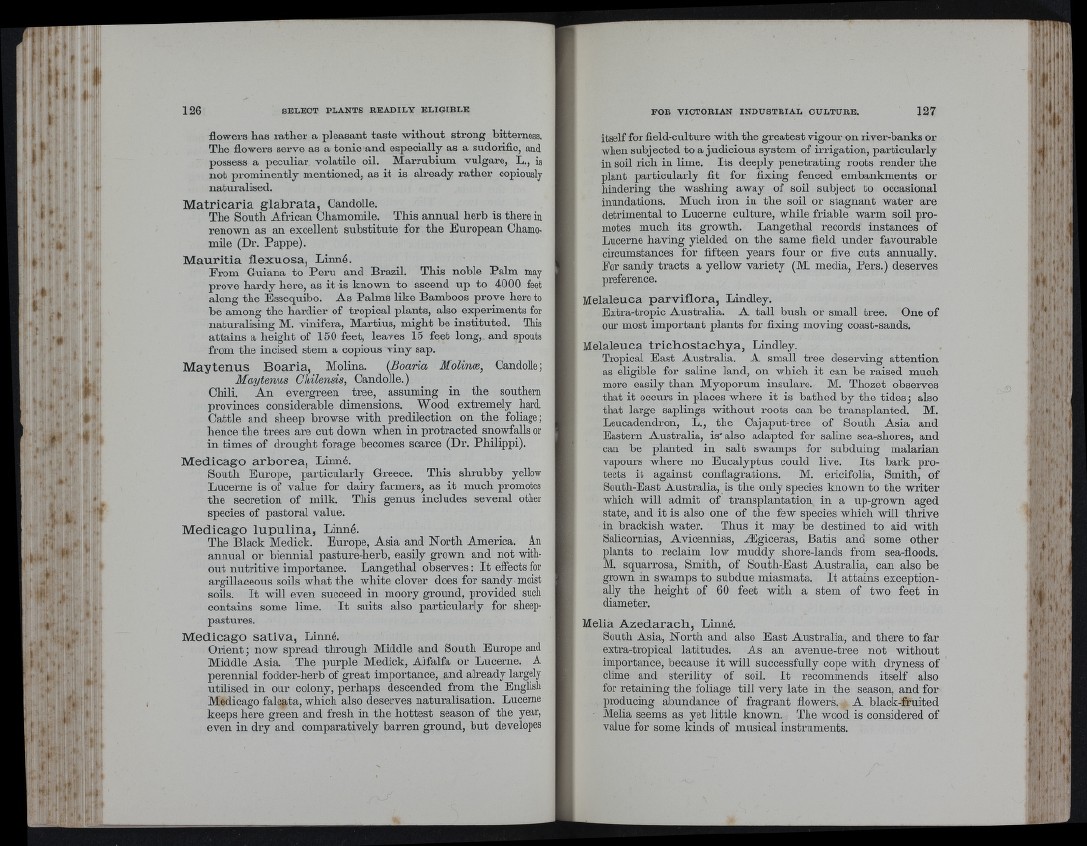
126 SELECT PLANTS READILY ELIGIBLE
flowers has rather a pleasant taste without strong bitterness.
The flowers serve as a tonic and especially as a sudorific, and
possess a peculiar volatile oil. Marrubium vulgare, L., is
not prominently mentioned, as it is already rather copiously
naturalised.
Matricaria glabrata, Candolle.
The South African Chamomile. This annual herb is there in
renown as an excellent substitute for the European Chamomile
(Dr. Pappe).
Mauritia flexuosa, Linné.
Erom Guiana to Peru and Brazil. This noble Palm may
prove hardy here, as it is known to ascend up to 4000 feet
along the Essequibo. As Palms like Bamboos prove here to
be among the hardier of tropical plants, also experiments for
naturalising M. vinifera, Martins, might be instituted. This
attains a height of 150 feet, leaves 15 feet long, and spouts
from tbe incised stem a copious viny sap.
M ay t e n u s B o a r ia , Molina. {Boaria Molinoe, Candolle;
Maytenus Chilensis, Candolle.)
Chili. An evergreen tree, assuming in the southern
provinces considerable dimensions. Wood extremely hard.
Cattle and sheep browse with predilection on the foliage;
hence the trees are cut down when in protracted snowfalls or
in times of drought forage becomes scarce (Dr. Philippi).
Medicago arborea, Linné.
South Europe, particularly Greece. This shrubby yellow
Lucerne is of value for dairy farmers, as it much promotes
the secretion of milk. This genus includes several other
species of pastoral value.
Medicago lupulina, Linné.
The Black Medick. Europe, Asia and North America. An
annual or biennial pasture-berb, easily grown and not without
nutritive importance. Langethal observes : I t effects for
argillaceous soils what the white clover does for sandy moist
soils. I t will even succeed in moory ground, provided such
contains some lime. I t suits also particularly for sheep-
pastures.
Medicago sativa, Linné.
Orient ; now spread through Middle and South Europe and
Middle Asia. The purple Medick, Alfalfa or Lucerne. A
perennial fodder-herb of great importance, and already largely
utilised in our colony, perhaps descended from the English
Medicago falcata, wbicli also deserves naturalisation. Lucerne
keeps here green and fresh in the hottest season of the year,
even in dry and comparatively barren ground, but developes
FOR VICTORIAN INDUSTRIAL CULTURE. 127
itself for field-culture with the greatest vigour on river-banks or
when subjected to a judicious system of irrigation, particularly
in soil rich in lime. Its deeply penetrating roots render the
plant particularly fit for fixing fenced embankments or
hindering the washing away of soil subject to occasional
inundations. Much iron in the soil or stagnant water are
detrimental to Lucerne culture, while friable warm soil promotes
much its growth. Langethal records instances of
Lucerne having yielded on the same field under favourable
circumstances for fifteen years four or five cuts annually.
Eor sandy tracts a yellow variety (M. media, Pers.) deserves
preference.
Melaleuca parviflora, Lindley.
Extra-tropic Australia. A tall bush or small tree. One of
our most important plants for fixing moving coast-sands,
Melaleuca tricbostacbya, Lindley.
Tropical East Australia. A small tree deserving attention
as eligible for saline land, on which it can be raised much
more easily than Myoporum insulare. M. Thozet observes
that it occurs in places where it is bathed by the tides; also
that large saplings without roots can be transplanted. M.
Leucadendron, L., the Cajaput-tree of South Asia and
Eastern Australia, is'also adapted for saline sea-shores, and
can be planted in salt swamps for subduing malarian
vapours where no Eucalyptus could live. Its bark protects
it against conflagrations. M. ericifolia, Smith, of
South-East Australia, is the only species known to the writer
which will admit of transplantation in a up-grown aged
state, and it is also one of the few species which vfill thrive
in brackish water. Thus it may be destined to aid with
Salicornias, Avicennias, Ægiceras, Batis and some other
plants to reclaim low muddy shore-lands from sea-floods.
M, squarrosa. Smith, of South-East Australia, can also be
grown in swamps to subdue miasmata. I t attains exceptionally
the height of 60 feet with a stem of two feet in
diameter.
Melia Azedarach, Linné.
South Asia, North and also East Australia, and there to far
extra-tropical latitudes. As an avenue-tree not without
importance, because it will successfully cope with dryness of
clime and sterility of soil. I t recommends itself also
for retaining the foliage till very late in the season, and for
producing abundance of fragrant flowers. A black-fruited
Melia seems as yet little known. The wood is considered of
value for some kinds of musical instruments.
i,t: '
'I
Ii
I
I
B 'i i ■ .